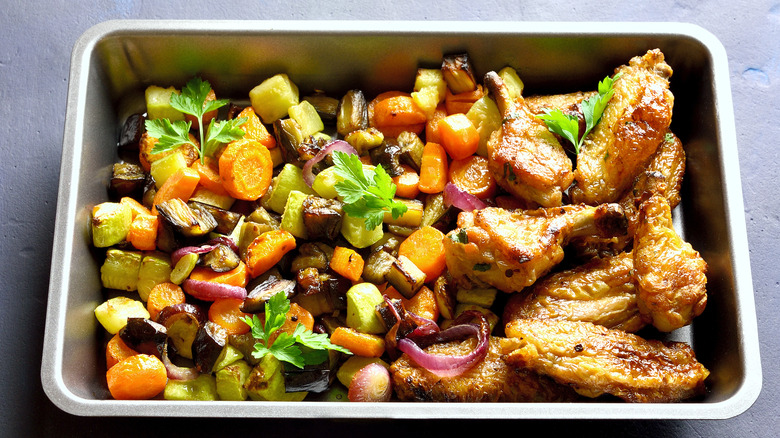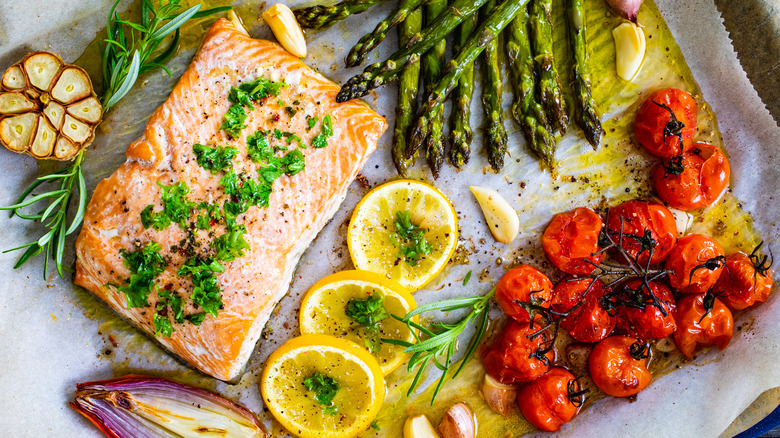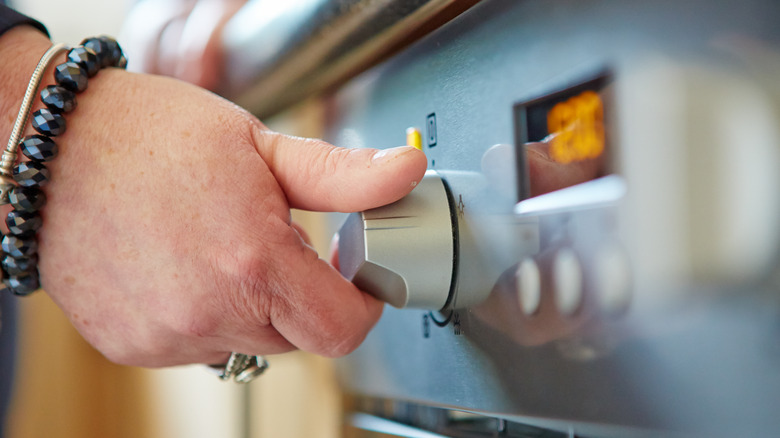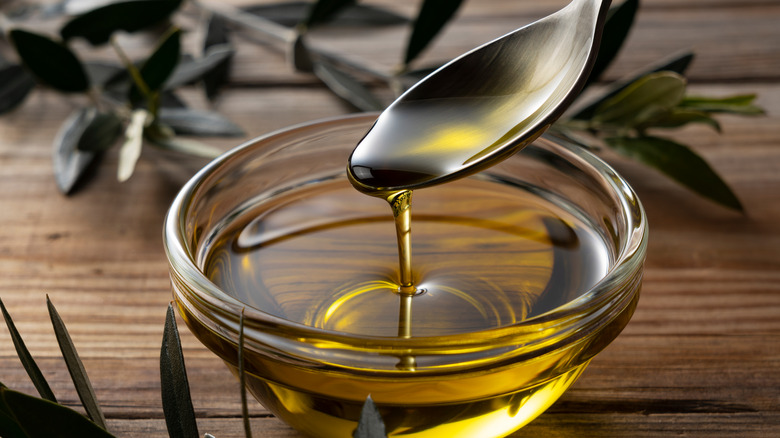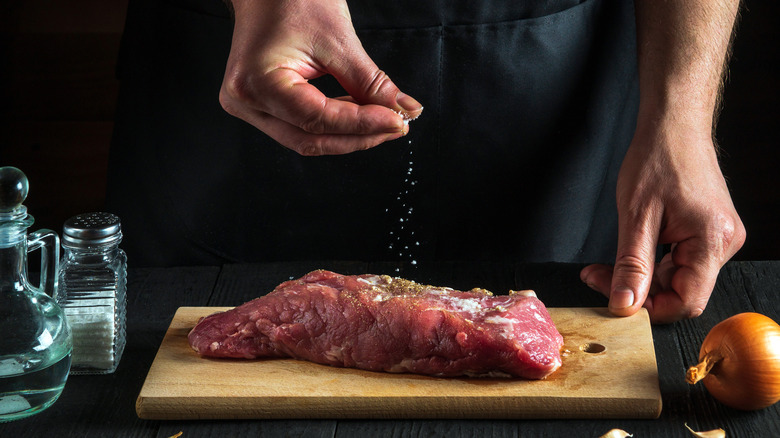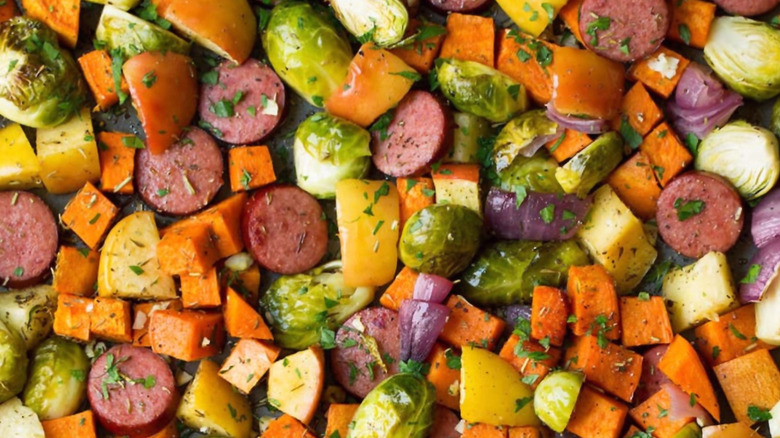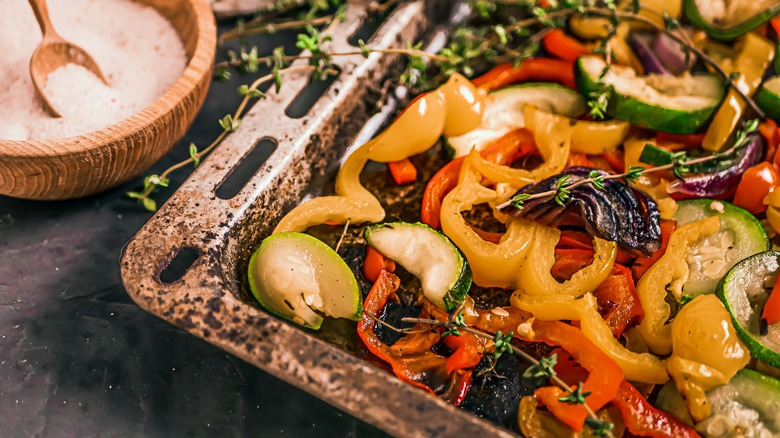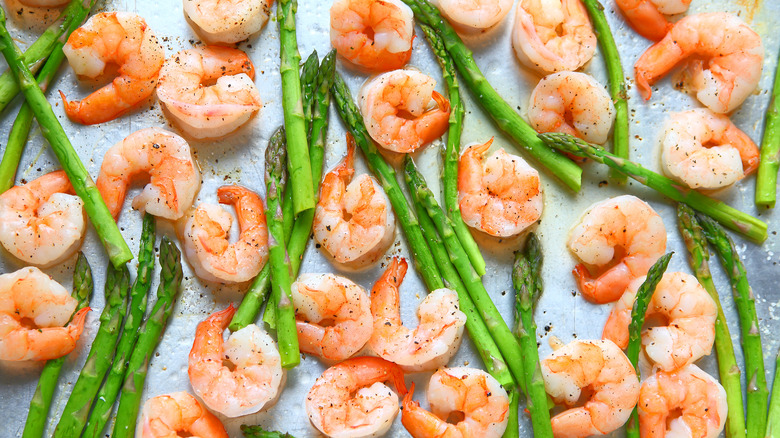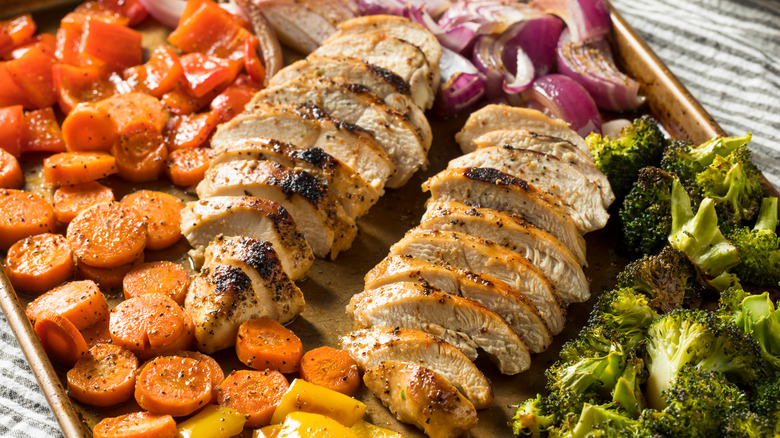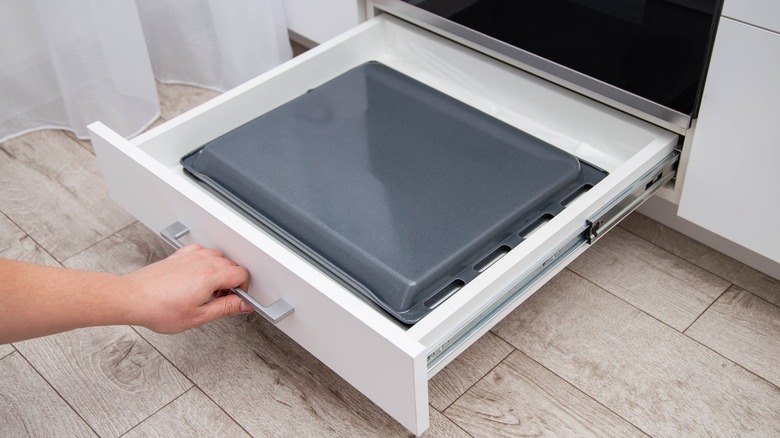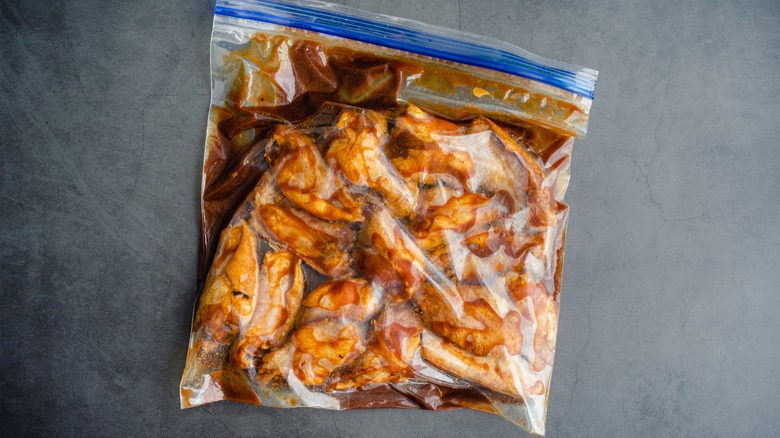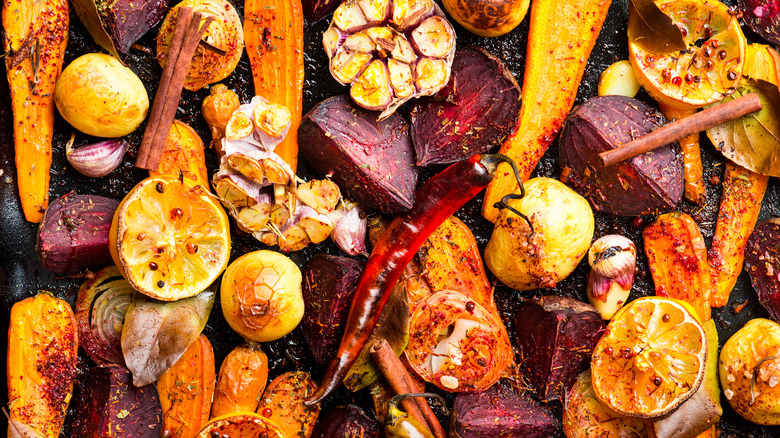Big Mistakes Everyone Makes With Sheet Pan Meals
When it comes to easy, affordable, mess-free meals, cooking on a sheet pan is a game changer! It doesn't matter whether you're a busy mom or dad rushing to feed a family, a college student on a budget, or just someone who loves to cook but hates doing dishes, sheet pan meals are the ideal solution. Of course, sheet pans are incredibly easy to prepare, but the benefits go beyond that: They're also super versatile. You can make uber-healthy and delicious meals in sheet pans.
No wonder the internet, and social media in particular, are so enraptured with the idea of sheet pan meals lately. After all, what could be better than throwing everything you want to eat together on a giant pan, seasoning it, and then popping it in the oven? Twenty or thirty minutes later, you've got an easy, tasty meal with minimal mess: It's perfect, right?
Well, almost perfect. Sheet pan meals may be simple to prepare, but the meals aren't foolproof. Combine mismatched ingredients, grab the wrong pan, or time your meal poorly, and you can end up with a bland, disappointing dinner instead of the beautiful plate of food you were hoping for. But while there are a number of common mistakes that can mess up even the best-intentioned sheet pan meal, the good news is that correcting these errors (before they happen) is fairly easy.
Never overcrowd your sheet pan
The beauty of a sheet pan meal is that you can just toss a bunch of ingredients on a cooking sheet and let your oven do the rest. But overcrowding your sheet pan and piling too many ingredients on there usually results in disaster. When the ingredients you are trying to cook are stacked on top of each other or packed too tightly together, you've created a sure-fire recipe for uneven cooking. So while some of the carrots or slices of pepper, or chunks of chicken in your meal may turn out fine, other pieces can be overcooked or even end up burning. (The more crowded your sheet pan is, the longer everything takes to cook, which can lead to unintended burning and charring.)
Overcrowding a sheet pan meal also increases the chances that your food will turn out soggy. As individual ingredients cook, they release moisture that turns to steam, and if you have a bunch of chunks of food steaming each other, your meal will end up soggy. To avoid overcooking your sheet pan meal, make sure you always use the biggest pan available so you have plenty of space to spread out your ingredients in a thin, even layer with adequate space between them. And if you're cooking a lot, don't just pile it all on there. Use two baking sheets so overcrowding is never a problem.
Don't forget to preheat the oven
Preheating the oven is a must for delicate jobs like baking, but it's just as important for cooking techniques like making a sheet pan meal. If you neglect to preheat your oven, everything on your sheet pan will start cooking at a lower temperature, and they will also be more likely to cook unevenly even once the oven reaches the desired temperature range. Not preheating your oven can also cause longer cooking times for your sheet pan meal, and it's an immediate precursor to an overcooked or possibly even burnt dish.
Finally, and perhaps most importantly, not preheating the oven can also lead to potential food safety issues. When your oven is not preheated, the temperature inside the oven may not be hot enough to kill harmful bacteria on proteins like chicken or pork in particular. Combine that with the threat of potential undercooking, and you could be looking at some serious food-borne illnesses. Luckily, avoiding this problem is quick and easy.
Just make sure you always click your oven on right when you start preparing your meal. You will likely only need 10-15 minutes for the oven to reach the correct temperature, and that should be about the time it takes to grab and prep all your ingredients. If you're not sure about the temperature at which you should set your oven, 350 to 400 degrees Fahrenheit is a good pre-heating range for most sheet pan meals.
Avoid using too much oil
Sheet pan meals don't usually require a lot of oil. That's why using too much oil continues to be one of the biggest mistakes novice chefs make when planning these all-in-one dinners. The biggest difference between frying and cooking a sheet pan meal is that oil doesn't cook off in the same way. So if you load your sheet pan meal with oil, it's going to pool around whatever you are baking, and unfortunately, you're going to end up with a dish that's incredibly greasy and unappetizing.
Too much oil is also bad for the baking process, causing the food in the oven to steam rather than baking or roasting and thereby eliminating all the delicious crust, char, and caramelization you are looking for from your sheet pan dish. In general, when it comes to oil and sheet pan cooking, you want just enough oil to lightly coat the food and prevent sticking, and no more.
To attain the perfect results, you should never pour your oil directly on the sheet pan. Instead, use an oil mister and apply a light mist of oil to your food before placing it on your sheet pan. Or, add a tablespoon of oil to your bowl of ingredients and toss everything by hand. If it still seems dry, just add more oil.
Not adding enough seasoning to the food
One of the most common issues home cooks notice about sheet pan meals is that they can be bland or boring. But seasoning your food properly is an easy mistake to correct and an ideal way to ensure your sheet pan meal ends up as rich and flavorful as possible. The first thing to remember is that in almost all cases, salt and pepper are not enough to make an incredible-tasting sheet pan meal. You need aromatics, dried spices, or even fresh herbs to really make your meal shine.
Swear off your bland and boring meal by making sure to always start the seasoning process early, and add all your spices to your ingredients at the same time you are coating them with oil, so flavors have time to cook and meld together as the food roasts or bakes.
Commit to also always using a variety of seasonings to season your sheet pan meal. You want the kind of complex flavor profiles that only come from pairings like cumin, coriander, ginger or chili powder, cumin, smoked paprika, or even garlic, basil, oregano, and red pepper flakes: Think big and bold! And remember, it's important to taste as you go. This will help you to achieve a balanced flavor profile for your well-seasoned and delicious meal.
Cutting the ingredients too uneven or small
Sheet pan meals allow you to cook a bunch of different things at once. But in order for that process to be successful, you do need to take certain precautions, like ensuring all the ingredients you prep and dice up are at least a consistent size and shape. Cutting ingredients too small increases the chances of uneven cooking. Think about it: if you have a chunk of a 2-inch carrot and a piece of a 1-inch carrot, the thinner carrot is obviously going to cook in less time than the bigger one. That's why ingredients that are cut up into evenly sized pieces are so important: You want them to cook evenly in the same amount of time.
Similarly, unevenly prepared ingredients are also likely to brown or crisp at different rates, so you will end up with small pieces that are potentially overcooked and larger pieces that are still underdone. The general rule of thumb when it comes to sheet pan meal prep is to cut items that take longer to cook (like carrots or potatoes) into slightly smaller pieces than you would foods that cook quickly, such as peppers or mushrooms: Just don't go too small! If you chop sheet pan meal ingredients up too finely, they can also become mushy and lose their crunch. So think like Goldilocks as you prep: not too big, not too small: You want everything to be just right!
Keep an eye on the temperature
Cooking food at too high or too low a temperature can make any sheet pan meal crash and burn: Literally! If the temperature is too high, the food on the outside of the pan may cook too quickly and burn, while the food in the middle of the pan may not cook enough. On the flip side, if the temperature is too low, your ingredients may take too long to cook, resulting in a dry or overcooked mess.
Individual ingredients, too, react to different temperature extremes as well. Vegetables cooked at too high a temp may wind up mushy; proteins cooked at too high a temperature can become tough or chewy. If you're following a recipe for your sheet pan meal, then you have some guidelines to follow. But if you are making up a meal on the fly, it can be more challenging.
In that case, try to plan your meals around foods that take a similar amount of time to cook: Think salmon with asparagus and potatoes or chicken with Brussels sprouts and carrots. Quicker meals that require a bit less time might include softer foods like tofu with bell peppers and zucchini or Italian sausage with onions and peppers. In general, you want to use high heat (400 to 450 degrees Fahrenheit) for vegetables. This will allow them to cook and crisp on the outside. Proteins need a lower temperature range of around 350 to 400 degrees Fahrenheit.
Alway use parchment paper or cooking spray
Whenever you are baking something in the oven, food sticking to the pan is the enemy. That's why using either cooking spray or parchment paper is crucial. Both parchment paper and cooking spray pack several benefits when it comes to sheet pan meals. First off, using them will help your food to taste better: You'll get all those delicious charred and crispy bits that might otherwise stick to the pan. They also help to prevent burning if your ingredients are a little too damp or not damp enough and begin sticking to the pan as they cook. Finally, parchment paper and cooking spray ensure that cleaning up after making a sheet pan meal is a breeze.
To really protect your pans, try this incredible tip from Stephen Chavez, chef-instructor at the acclaimed Institute of Culinary Education suggests spraying nonstick spray on the sheet pan, then putting down some foil, and adding nonstick pan spray again on top of that once again. According to Chavez, this is a great way to not only minimize sticking and also greatly reduce mess. Chavez notes that doing this will help keep your sheet pans in good condition and prevent the build-up and discoloration that would take place otherwise.
Don't try to make your sheet pan meal Instagram pretty
Sure, part of the charm of a sheet pan meal is that you can have all your ingredients laid out in a picture-perfect spread before you pop everything in the oven. But mixing together a bunch of different ingredients that are cut in different shapes and that all have different cooking times is a huge mistake when it comes to making a sheet pan meal, according to chef Stephen Chavez. Chavez doesn't mix all the ingredients together; instead, he puts them in the pan in small piles.
Rather, Chavez says he adds all of his different ingredients to the cooking sheet at once and puts everything in the oven. And then he watches the ingredients as they cook, tossing the piles as needed. If his green beans are done after 10 minutes, and the rest of his ingredients are not, he takes the cooking sheet out of the oven and removes those beans. Foods that need longer to cook stay in the oven as long as needed; the stuff that is done is removed from the pan as it becomes ready. While you may want an Instagram-worthy mixture of vegetables, according to Chavez, it's best to cook the ingredients separately, combine them together, and then take a picture.
Using a low-quality sheet pan is a big mistake
Consider this: when a sheet pan is poor quality, it's much more likely to cause uneven cooking. It's also going to be harder to clean properly when your meal is done. And if your sheet pan is non-stick and has perhaps begun to crack or break down, there's also the chance it could be releasing potentially toxic coatings into your meal, and no one wants that! When selecting a high-quality sheet pan, look for brands made from aluminum, stainless steel, or carbon steel. Aluminum is a lightweight material, and it's better at conducting heat, while stainless steel is more durable and is a good choice for long-term use.
As for size, most sheet pans are available in three different shapes: Quarter sheet pans (9 x 13 inches); half sheet pans (13 x 18 inches); and full sheet pans (18 x 26 inches). For most sheet pan meals, the half sheet pan is generally the best size to use. It's large enough to accommodate a variety of ingredients but not so large that the food will be spread out too thinly. It also fits easily into most standard ovens without being too large to cause problems. Buy the best quality pan possible, and make sure that is nice and thick: 18 gauge is generally considered the highest quality for sheet pans. This extra density will prevent warping and bending when the pan is exposed to heat: Essential!
Embrace sauces and marinades
Many sheet pan meals end up tasting incredibly dry and bland. But adding sauces and marinades to your food before you bake it is a great way to not only increase moisture levels but also amp up that missing flavor. As we've already mentioned, one thing to watch out for with sheet pan meals is trying to cook foods that are too wet as they steam instead of baking or roasting. But it's possible to use a sauce or marinade in a sheet pan meal: You want ingredients that are damp but not dripping wet. The liquid shouldn't pool around your ingredients when they are placed on your cooking sheet.
Besides adding needed flavor and moisture, sauces and marinades play an incredible role in making a good sheet pan meal great. Marinades can help tenderize the meat. Similarly, a good sauce can help create a crispy, caramelized exterior on the outside of your ingredients while also helping to keep the inside moist and tender. Plus, sauces and marinades are completely customizable so they are also a great way to make sure whatever dish you are preparing is uniquely you and it's perfectly suited to your and your friends or family's taste buds. Keep your options wide as you consider sauce and marinade options. Citrus juices, balsamic vinegar, honey, red wine vinegar, Dijon mustard, soy sauce, chimichurri, and pesto can all be great options! Try them all.
Don't be afraid to experiment with different ingredients
Finally, and perhaps most importantly, don't make the common sheet pan meal mistake of cooking the same boring foods over and over again. Not experimenting with different ingredients when preparing a sheet pan meal is a big mistake because it can make your meals repetitive and predictable. Sure, carrots and onions and peppers and potatoes taste great as part of a sheet pan meal. But they shouldn't be the only tools in your mealtime arsenal. Branch out and consider different spices or herbs you can experiment with, or vegetables or fruit you may not know as much about but that could be a delicious addition to your sheet pan meal.
A few ideas to get you started include adding fennel to your next fish or chicken sheet pan meal. The unique sweet and licorice-like flavor of this often under-utilized veggie pairs perfectly with both proteins. Pomegranate seeds are another great option! These tiny and colorful seeds can add a pop of flavor and texture to any sheet pan meal, and they taste great with most roasted vegetables or grilled meats. You can also add cooked quinoa to your sheet pan along with vegetables and proteins. Or consider some diced Halloumi cheese. It's firm and salty and tastes incredible grilled or roasted on a sheet pan meal with peppers, eggplant, or zucchini: So many options, so many sheet pans meals you can make. Enjoy your sheet pan adventures!
